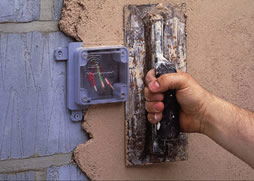A new series of Regulations (522.6.6 - 522.6.8) have been introduced in the 17th Edition of the IEE Wiring Regulations concerning cables concealed in a wall or partition. These new Regulations introduce the concept of skilled person, instructed person and ordinary person.

RCD PROTECTION
It is now a requirement to protect cables concealed in a wall or partition (at a depth of less than 50 mm) by a 30 mA RCD where the installation is not intended to be under the supervision of a skilled or instructed person where other methods of protection, including the use of cables with an earthed metallic covering, earthed conduit/trunking or mechanical protection, can not be employed.
Irrespective of the depth, a cable in a partition where the construction includes metallic parts other than fixings shall be protected by a 30 mA RCD.
For example, this means that in a domestic installation, where insulated and sheathed cables are concealed in a wall at a depth of less than 50 mm and have no mechanical protection, they need to be installed within the safe zones and protected by a 30 mA RCD.
DEFINITIONS
Skilled person
A person with technical knowledge or sufficient experience to enable him/her to avoid dangers which electricity may create.
Instructed person
A person adequately advised or supervised by skilled persons to enable him/her to avoid dangers which electricity may create.
Ordinary person
A person who is neither a skilled person nor an instructed person.
WIRING SYSTEMS
To conform with the requirements of BS 7671, wiring systems must utilise cables complying with the relevant requirements of the applicable British Standard or Harmonised Standard.
Alternatively, if equipment complying with a foreign national standard, based on an IEC Standard is to be used, the designer or other person responsible for specifying the installation must verify that any differences between that standard and the corresponding British Standard or Harmonised Standard will not result in a lesser degree of safety than that afforded by compliance with the British Standard.
The effect of environmental conditions and general characteristics around various parts of the installation must be assessed to enable suitable electrical equipment, including the wiring system, to be specified.
For example, cables and equipment used in agricultural and horticultural premises should be installed away from areas or routes used by animals or be of a type to withstand such attack.
Any part of the fixed installation which may be exposed to a severe impact must be able to survive it. In workshops, for example, where heavy objects are moved, installation of wiring systems in traffic routes should be avoided or localised protection must be provided.
To read the full article, please see attachment below.
Originally published in Wiring Matters, Summer Edition 2008, written by Geoff Cronshaw.
